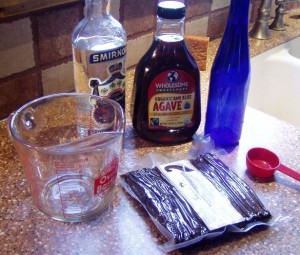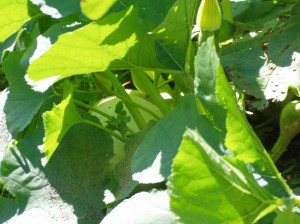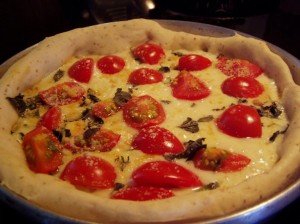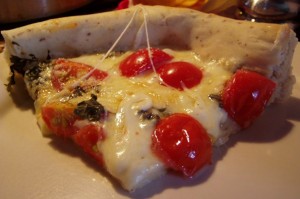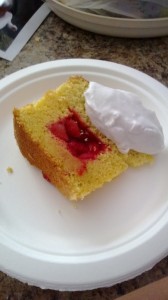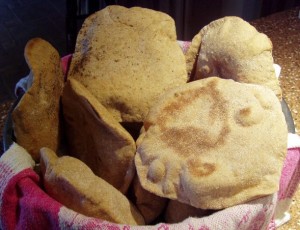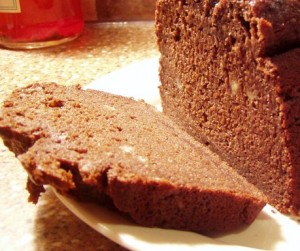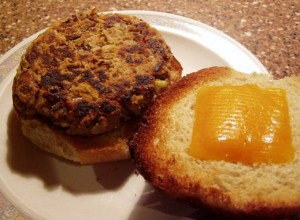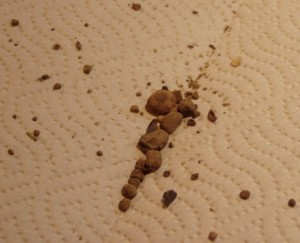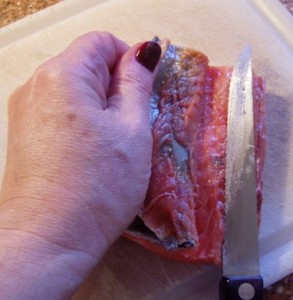 A couple of years ago, we found a family who live a couple of hours away from us, who have a business whereby they go up to Alaska and fish for salmon. They have it processed up there and sent back and they sell it locally. So, we buy their product because a) it’s cheaper than any wild salmon we can find in stores locally and b) it’s supporting a small local business.
A couple of years ago, we found a family who live a couple of hours away from us, who have a business whereby they go up to Alaska and fish for salmon. They have it processed up there and sent back and they sell it locally. So, we buy their product because a) it’s cheaper than any wild salmon we can find in stores locally and b) it’s supporting a small local business.
One of the products they sell is a wicked salmon burger (which is probably made out of all the trimmings left over after the fish have been made into filets). These burgers are very tasty, and made with dill and feta cheese. They are a quick and easy dinner – pull them out of the freezer, throw them into a pan on the stove or bake them in the oven, make a salad and another veg and off you go.
Seriously, they are amazingly good. Except for one thing – the amount of sodium in them would stop a horse. Since the DH and I like to watch our sodium intake (yes, your dear Aunty has entered the age when watching the sodium is an important thing), this is very upsetting because we really like those salmon burgers.
So, I threw the kitchen at Chez Siberia into complete chaos today in efforts to figure out something sort of like those salmon burgers but without using a high salt cheese (now, if you can use canned salmon to do this also, you just have to go down to the bit after I’ve worked with the fresh fish – Step 3).
To do this, you will need the following (this makes 8 burgers):
— About 1.5 pounds of salmon fillets, or an equivalent amount of canned salmon
— 1 cup Ricotta cheese, drained (I put mine in a fine sieve in the fridge first thing in the morning for a couple of hours and it worked like a charm)
— 1 Tblspoon of dried dill
— 1 tsp. oregano
— 1/4 c. of breadcrumbs (if you have flavored ones, they tend to mask the flavor of the dill a bit but it still tastes very good)
Step One: Get the skin off the salmon. This is the only somewhat tricky bit.
Holding the fillet skin down, carefully cut at one end down through the fish until you get to the skin.
Flip it over and as you see in the photo at the top, start peeling the skin away with one hand while you carefully slice away the fish from the skin. If you leave some fish on the skin, that is OK — just use your sharp knife to slice that away at the end and throw that into the bowl with the rest of the fish.
Step Two: Chop up the fish.
You can use a food processor for this, but I like to go through fish with my fingers to make sure I have not missed any bones. So, once you’ve done that, if you have a food processor, just throw the fish in, and chop it up. I just used a knife and chopped it as finely as I could. Put the chopped up fish into a big bowl.
Add the Rocottoa, the dill, the oregano and the breadcrumbs, mix it up thoroughly and start making burgers.
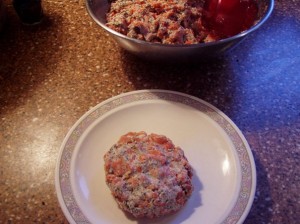 I used a half-cup measure and this makes a really nice burger. Remember – this is salmon and the ricotta does not shrink either so this burger will stay nice and big even after cooking. If you want to serve this on a bun (whole grain, please… or GF if you swing that way), you’ll need a regular sized bun. These burgers do not shrink in cooking.
I used a half-cup measure and this makes a really nice burger. Remember – this is salmon and the ricotta does not shrink either so this burger will stay nice and big even after cooking. If you want to serve this on a bun (whole grain, please… or GF if you swing that way), you’ll need a regular sized bun. These burgers do not shrink in cooking.
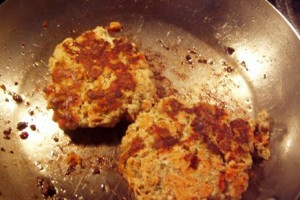 I tried these out both baked in the oven at 375 degrees F. for 20 min. and in a frying pan with a little bit of oil, five minutes on a side. Both methods work fine with these and they tasted great. Did they taste like the commercial feta and dill ones?
I tried these out both baked in the oven at 375 degrees F. for 20 min. and in a frying pan with a little bit of oil, five minutes on a side. Both methods work fine with these and they tasted great. Did they taste like the commercial feta and dill ones?
No. I have to tell the truth. They don’t. They also don’t have all the sodium, either.
Just for a point of comparison:
1 cup of Ricotta Cheese: 200 mg. of sodium
1 cup of feta, crumbled: 1460 mg. of sodium
So, there you go.
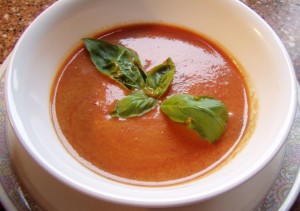 We all have connections with food that we ate when we were young (shoot, Proust wrote a 900+ page novel based on his scent memory of what is actually a rather small vanilla cookie). Whether it’s some sort of soup or mac and cheese or a cookie or pie only made at holiday time, we all have these memories and feelings associated with food from his period. Of course, there are always the emotional ties involved with who was making them, how we felt about that person, the circumstances associated with them (were you standing on a stool with a huge apron hiked up around your armpits helping, covered in flour from head to heels?) and so on.
We all have connections with food that we ate when we were young (shoot, Proust wrote a 900+ page novel based on his scent memory of what is actually a rather small vanilla cookie). Whether it’s some sort of soup or mac and cheese or a cookie or pie only made at holiday time, we all have these memories and feelings associated with food from his period. Of course, there are always the emotional ties involved with who was making them, how we felt about that person, the circumstances associated with them (were you standing on a stool with a huge apron hiked up around your armpits helping, covered in flour from head to heels?) and so on. 